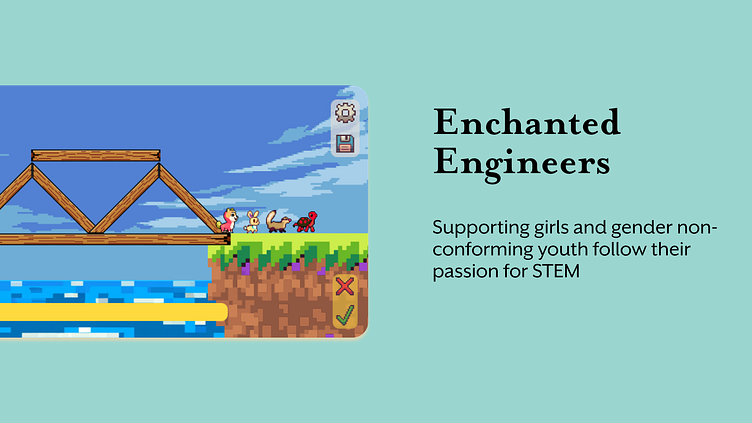Enchanted Engineers
Overview
Enchanted Engineers is a mobile game that aims to inspire young women and gender non-conforming people to pursue their passion in STEM. In Enchanted Engineers, you are one of the top students at the magical academy. One day there is a magical shutdown. It is up to you to save your home by traveling to the mysterious islands in the south to re-discover the ancient art of Engineering. You are confronted by a series of cuddly adversaries, but you’re not alone. You’ve got your own cuddly allies and a wealth of resources to reconnect the islands and save your home.
Role:
UX Designer
Duration:
3 months
Team:
Max Salire
Sasha Somer
Tools:
Figma, After Effects
Skills:
UX Design, Game Design, User Research
Defining the Problem
We have an issue on our hands. As of 2020, women comprise around 25% of the STEM workforce - only a slight increase in the last 30 years. On the surface level, maybe it seems young women and gender-nonconforming individuals just aren’t interested in STEM.
However, research shows it’s not that non-men aren’t interested. In fact, young women tend to perform at higher rates in STEM subjects. The real problem lies with how toxic STEM can be to women and gender non-conforming people, and this starts as early as middle school.
With this understanding in hand, we set out to design a game that solved The Real Problem.
Research
How can a game help with the gender imbalance in STEM?
The first question we asked in our research was: can a game help with the gender imbalance in STEM?
A study from the American Association of University Women notes that math and science are skills that can be developed rather than inherent traits that you have or don’t have. This is crucial for girls and non-men to overcome the negative stereotypes about STEM fields being for men.
Another key study in our research, from NYU, found that video games are particularly good at getting students out of a “performance” mindset, where they are just performing for validation or avoiding embarrassment, and into that crucial “growth” mindset.
Key Takeaways
STEM skills are developed, not inherent.
We need to instill a "growth" mindset in our gamers.
Video games help people get out of a "performance" mindset, and into a "growth" mindset.
What type of game speaks to our audience?
We found that women and gender non-conforming people in our target age bracket, 11-13, tend to prefer casual, single-player, resource-gathering games, set in bright, beautiful worlds with a rich story.
User Personas
We found that women and gender non-conforming people in our target age bracket, 11-13, tend to prefer casual, single-player, resource-gathering games, set in bright, beautiful worlds with a rich story.
We used our research to create three user archetypes to guide our development.
Design Process
Competitor Analysis
For competitor analysis, we looked at the game design and visual design of similar games. We took cues on the UI design and gameplay from games like Bridge Builder, Stardew Valley, and Sun Haven, as well as their art direction (8-bit style, bright colors)
Designing the Bridge Puzzle
Most bridge-building games don’t increase in complexity throughout the course of gameplay (the emphasis is more on the quantity and length of the bridge). We decided to differentiate our game by basing our puzzles on real types of bridges, making them increase in complexity as the gamer leveled up, and incorporating them into the narrative of the game.
Design System
Addressing Jobs to be Done
We employed the Jobs to be Done (JTBD) framework to identify and address the emotional and functional needs of our users. We identified three main jobs:
Feel empowered and safe
Gain a sense of accomplishment
Have a creative outlet
Feel empowered and safe
We addressed that need in how our game allows users to stand up to cuddly adversaries. Our adversaries challenge the player, and we’ve provided responses they can say to stand up for themselves. We hope this can allow the users some sense of safety, in that they don’t have to think on the spot and are given a script. We also hope that these scripts can help empower them down the line in their STEM careers.
Gain a sense of accomplishment
Another JTBD is to gain a sense of accomplishment, specifically a STEM accomplishment. In our game players gain accomplishment by resource gathering, and by completing a series of bridge-building puzzles. These puzzles increase in complexity as the player levels up throughout the game
Resource gathering
Bridge puzzle
Have a creative outlet
The last job we identified was the need for a creative outlet. We address this in our game by allowing players to customize their avatars with these hand-drawn illustrations, which allow for a variety of gender expressions.
Positioning the game
One remaining issue of Enchanted Engineers was the question of how players would access it. Independently via an app store? Through an education system? Nothing takes the fun out of a game more than being forced to play it, so we opted out of positioning our game as solely educational and administered through teachers. We decided to offer Enchanted Engineers for free, independent play, and also partner with like-minded STEM organizations to offer scholarships to our players.
Next steps
Introduce role models into the game narrative that are modeled off of real women STEM heroes from history.
Build out Enchanted Engineers in Unity
Launch a scholarship program that funds top players to study STEM in higher ed.
Build a partnership program with STEM organizations that support women and non-men (e.g. Girls Who Code)



































